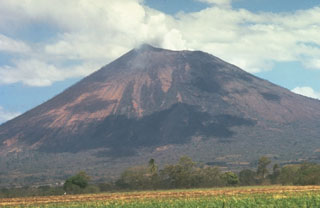Report on San Cristobal (Nicaragua) — December 1980
Scientific Event Alert Network Bulletin, vol. 5, no. 12 (December 1980)
Managing Editor: David Squires.
San Cristobal (Nicaragua) Moderate vapor plume
Please cite this report as:
Global Volcanism Program, 1980. Report on San Cristobal (Nicaragua) (Squires, D., ed.). Scientific Event Alert Network Bulletin, 5:12. Smithsonian Institution. https://doi.org/10.5479/si.GVP.SEAN198012-344020
San Cristobal
Nicaragua
12.702°N, 87.004°W; summit elev. 1745 m
All times are local (unless otherwise noted)
A moderate-sized vapor plume rose continuously from the summit. Remote sensing of SO2 revealed increased flux since June 1980, but SO2 emission remained far below the levels of the mid-1970's.
Further Reference. Zapata, R., 1981, La Actividad del Volcán San Cristóbal (Nicaragua), Iniciada el 24 de Agosto de 1980; Boletín de Vulcanología (Universidad Nacional, Heredia, Costa Rica), no. 11, p. 16-18.
Geological Summary. The San Cristóbal volcanic complex, consisting of five principal volcanic edifices, forms the NW end of the Marrabios Range. The symmetrical 1745-m-high youngest cone, named San Cristóbal (also known as El Viejo), is Nicaragua's highest volcano and is capped by a 500 x 600 m wide crater. El Chonco, with several flank lava domes, is located 4 km W of San Cristóbal; it and the eroded Moyotepe volcano, 4 km NE of San Cristóbal, are of Pleistocene age. Volcán Casita, containing an elongated summit crater, lies immediately east of San Cristóbal and was the site of a catastrophic landslide and lahar in 1998. The Plio-Pleistocene La Pelona caldera is located at the eastern end of the complex. Historical eruptions from San Cristóbal, consisting of small-to-moderate explosive activity, have been reported since the 16th century. Some other 16th-century eruptions attributed to Casita volcano are uncertain and may pertain to other Marrabios Range volcanoes.
Information Contacts: R. Stoiber, S. Williams, H.R. Naslund, L. Malinconico, and M. Conrad, Dartmouth College; A. Aburto Q., and D. Fajardo B., Instituto de Investigaciones Sísmicas.

